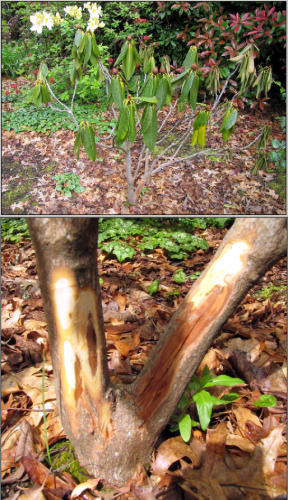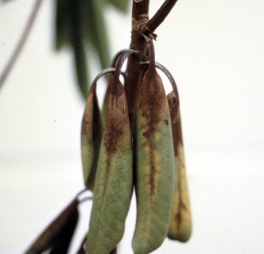Container grown rhododendrons and avoiding phytophthora root rot in the nursery
Suggestions to reduce the risk of Phytophthora root rot on container grown rhododendrons in the nursery. Water management, cultural practices and preventative fungicides all play a role.

Some areas in Michigan experienced multiple heavy rainfall events in the past month with over 6 inches of rainfall in some locations during June. According to Michigan State University Extension this could lead to Phytophthora root rot occurring on container grown rhododendrons in nurseries. Be sure you can accurately identify the symptoms that cause the root rot and dieback. Root rot symptoms early on are indicated by dull yellow, small leaves that begin to curl downward and inward eventually showing the wilt symptoms (Photo 1). Growers should check roots of plants with these symptoms, as infected roots will appear reddish-brown and be very brittle.
Growers can check for symptoms on the plant by scraping the bark on the main stem near the soil line. If infected, the reddish-brown discoloration of the stem is a symptom of this disease (Photo 2). To have a positive diagnosis, send infected plant material to the Michigan State University Diagnostic Services lab.

Photo 2. Top photo - Wilt symptoms. Bottom photo - Discoloration of cambium shown at transition zone of stem. Photo credit: Neil Bell, Oregon State University
Dieback symptoms occur on young, newly formed leaves and are characterized by circular, water-soaked, chocolate-brown spots. These areas dry out in a few days and infected leaves turn downward and remain attached to the stem (Photo 3). The Phytophthora may move downward from this infection into the stem and kill other tissue on the plant.

Photo 3. Crown rot symptoms of Phytophthora spp. Photo credit: Ethel Dutky, University of Maryland, Bugwood.org
These symptoms will lead to plant death, as the Phytophthora pathogen can work very fast in warm summer temperatures. Within 7-10 days symptoms can be seen when container media temperatures rise above 80 degrees Fahrenheit. Also, excessive rainfall and or irrigation can lead to more problems with this disease if your container media has too many fine particles. A good container media for this crop should contain10-15 percent air-filled pore space. A rule of thumb is that your media percolation rate should be at an inch per minute throughout the production cycle.
Use composted hardwood or conifer bark in the container mix as the disease suppressive properties should last for a year and assist in reducing the risk of this disease.
Container grown rhododendrons must be grown on a well-drained gravel-based bed, 4 inches or more that is graded to allow the water to run off and not puddle up under the containers. Avoid placing containers on poly sheets as this does not allow for containers to drain properly.
Other cultural practices to avoid Phytophthora include using clean irrigation water. Some pond or ditch waters contain the spores of this disease; well water is generally better.
Prevent potted plants from blowing over and allowing the foliage to touch the ground as this could lead to an infection. If pruning is required be sure you are disinfecting your shears. Also remove any plant debris to reduce the risk of disease spread.
Finally, soil fungicide drenches are used as preventative treatments. Below are details from the “Pacific Northwest Handbook” which are appropriate for our situation.
- Adorn at 1 to 4 fl oz/100 gal water plus another fungicide. Group 43 fungicide. 12-hr reentry.
- Alude at 6.3 to 12.7 oz/100 gal water applied as a soil drench at a rate of 25 gal solution/100 sq ft. Follow application with irrigation. Use only once per month. Group 33 fungicide. 4-hr reentry.
- Banrot 40 WP at 6 to 12 oz/100 gal water. Group 1 + 14 fungicide. 12-hr reentry.
- Fosphite at 3 quarts/100 gal water. Do not use copper products within 20 days of treatment. Group 33 fungicide. 4-hr reentry.
- Mefenoxam 2 AQ at 0.98 to 1.96 fl oz/100 gal water as a soil drench or at 1.23 to 2.45 fl oz/1000 sq ft followed by at least 0.5 inch rain or irrigation. Group 4 fungicide. 48-hr reentry.
- Stature SC at 6.12 to 12.25 fl oz/50 to 100 gal water. Use as a drench. Do not make more than 2 (two) sequential applications. Group 40 fungicide. 12-hr reentry.
- Subdue MAXX at 1.25 to 2.5 fl oz/1000 sq ft, irrigated in with 0.5 inch water within 24 hours. Group 4 fungicide. 48-hr reentry.
- Terrazole 35 WP at 3.5 to 10 oz/100 gal water. Group 14 fungicide. 12-hr reentry.
- Truban 30 WP at 3 to 10 oz/100 gal water. Group 14 fungicide. 12-hr reentry.
*The phenylamide and phosphonate fungicides used to manage Phytophthora do not kill this organism. They can only prevent establishment of the organism before it gets into the plant. They can also prevent continued growth if the organism is already inside the plant thereby delaying symptoms that might have developed. Once chemical activity has subsided with time, the organism can resume growth within infected plants.
Contact your local nursery extension educator for additional assistance on this issue. For additional information, see, “Phytophthora Root Rot and Dieback of Rhododendrons and Azaleas in the Midwest,” from University of Illinois Extension.



 Print
Print Email
Email




